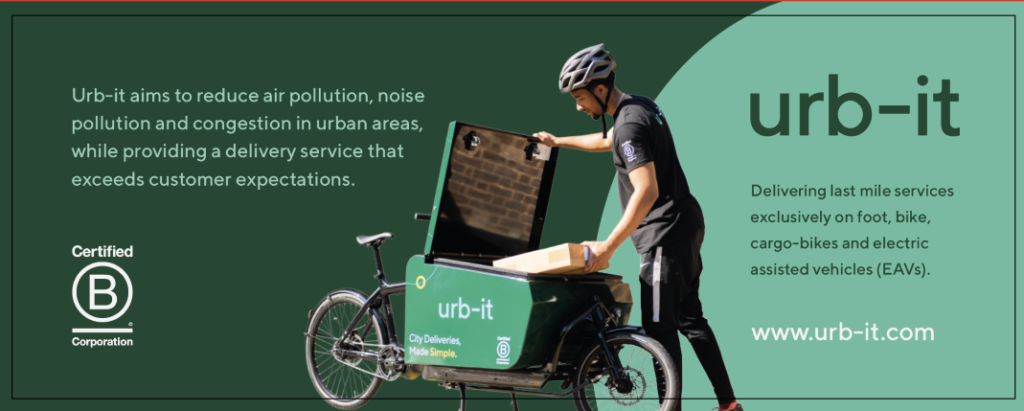As logistics organisations are looking to become more sustainable and make their operations greener, cargo bikes are becoming an important part of the provided service. The Logistics Point spoke to Charlie Ford, independent fleet consultant at Hatat Solutions about how logistics firms can choose the right bike, what changes are needed to the existing infrastructure and what are the costs.

‘It is a common challenge for companies to get stuck on which is the best cargo bike for their operations, when they have not experienced different bikes before,’ says Charlie. There are a small but growing number of cargo bike manufacturers across Europe (approx. 100 to date) with new companies entering the market every year. With this huge choice it is important to first consider the below factors before choosing a suitable cargo bike.
When choosing the right cargo bike for an operation companies should consider:
- Size of load
How much does the bike need to carry? Is the company looking for heavy and bulky items or small, light packages? This will define the type of box that is required and influence the style/shape required.
- How fast must the deliveries be?
This is important to consider as large 3- and 4-wheel bikes are not as fast 2 wheeled bikes at moving between traffic and due to their size and often have to travel on the road, so can get stuck in traffic.
- Storage space
An important point to consider is where to store the cargo bikes when not in-use, due to their size additional storage space may be required.
- Riders
Who will be riding the bikes? Are you as an organisation investing in riders’ training and competence? This is important as cargo bikes require skilled riders particularly 2-wheeled long-john style bikes, without sufficient training and up-skilling there will be an increased risk of accidents for the riders.
- Maintenance
It is essential that when you acquire or rent cargo bikes you also have in place a plan for maintenance – working with reputable suppliers to ensure the bikes are kept in good working order. Most cargo bikes used in a logistics setting will need at least fortnightly maintenance checks.
- Try before you buy
An essential part, once you have researched online or through speaking to cargo bike experts you can then reach out to companies offering demos/rentals. There are some new companies offering rentals which may be ideal for long-term testing of cargo bikes without the risk of investing in assets.
Cargo bikes have a number of advantages over traditional vans and even electric vans:
- No road tax
- No mandatory insurance
- No driving licence requirement (or penalty point insurance price impact)
- No parking charges or fines
- No road charging (ULEZ)
There is also the low cost to charge a cargo bike, even less than an E-Van in terms of cost per km in range. Additionally, cargo bikes can easily carry spare batteries and swap these out quickly to increase range, this is not possible with Electric vans currently on the market which must be left for several hours to charge.
‘Cargo bikes are faster at making deliveries than vans as they are more manoeuvrable, can use cycle lanes and move around traffic, it was reported in a study in central
London that journey times can be reduced by 25 – 50%,’ Charlie continues.
Storage and maintenance
Covered storage space is required for the cargo bike and a place to charge the batteries. It is recommended that metal charging cabinet lockers are used to store and charge the batteries overnight. ‘ In terms of road infrastructure cargo bikes can ride on the road and cycle lanes, there is work on-going with TfL in London and infrastructure organisations to widen cycle lanes to accommodate larger cargo bikes,’ Charlie comments on the state of current infrastructure.
In order to maintain cargo bikes companies will require specialist cargo bike mechanics, who are in short supply. However, regular cycle mechanics and motorbike mechanics can be trained on cargo bikes and will be able to quickly pick-up the skills required to service the bikes. It is recommended that training programmes are set up with the chosen manufacturer to ensure the mechanics are trained to the right standard and carry out maintenance in accordance with the manufacturer’s instructions.
Changing from vans
‘Switching from Vans to cargo bikes will require some upfront investment, which will include testing the bikes, acquiring spare parts, training and the purchase or deposit on rentals,’ Charlie admits. However, the impact of switching will be an immediate reduction in operational costs (fuel, tax, insurance, parking, ULEV etc.) and so savings will become apparent within 6 months from switching. It is recommended that bikes are rented or leased, similarly to how businesses acquire vans to lower the upfront cost and utilise the VAT savings from monthly payments. ✷
Join Charlie Ford on the 26th October to talk about last mile sustainabulity! Register now!



